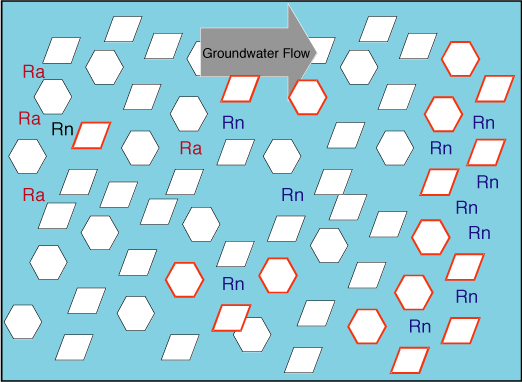


 |  |  | 5.3 Locating and Measuring Submarine Groundwater Discharge |
Identifying where SGD occurs and the rates of groundwater flux is no trivial matter. The most obvious SGD tracer in the coastal zone is salinity. Terrestrial aquifers contain freshwater while the salinity of coastal zone receiving waters will be higher, up to full oceanic salinity of 35 (or even higher in tropical lagoons). Through careful assessment of salinity signals, Johannes [251] identified groundwater discharge as an important source of water and dissolved compounds to a western Australian coastal lagoons, while, in the process, proposing the theoretical ubiquity of SGD.
Although the first ancient evidence of SGD was via the observation of active submarine springs in the coastal ocean, most groundwater discharge to the coastal zone (especially that from unconfined aquifers; Figure 2) is not accompanied by a marked freshening of surface receiving waters. Often SGD occurs with no discernible salinity signal at all. Other tracers may be helpful in cases where SGD is suspected due to coastal aquifer geometry (i.e., strike and dip) or biogeochemical observations in the absence of salinity anomalies.
Seasonally, temperature anomalies may be useful SGD tracers. Because groundwater temperatures remain relatively constant throughout the year, the temperature difference between surface water and groundwater will increase when surface water is warmed or cooled. Miller and Ullman [316] identified localized groundwater discharge to the Delaware coastal zone using remote thermal imaging to locate warm water plumes in cold winter surface waters. Similar techniques were used by Banks and colleagues [34] and Portnoy and colleagues [375] in separate studies of groundwater-surface water interactions. Moore and colleagues [319] inferred groundwater-surface water interactions from annual temperature excursions in a submarine confined aquifer located on the South Carolina continental shelf. Finally, Taniguchi and colleagues [459] calculated groundwater flux rates using subsurface temperature trends in Cockburn Sound, Western Australia.
An increasingly common, and powerful, tool for identifying SGD in the coastal zone is via chemical tracers, both natural and introduced. Natural radioactive elements, including radon-222 and a suite of radium isotopes (223Ra, 224Ra, 226Ra, and 228Ra) have been used as valuable tracers of SGD to estuarine and coastal zones (e.g., [317][64][272][408][80]). Artificial chemical tracers can be introduced into aquifer recharge zones to assess groundwater flow where flow lines are short (i.e., rapid discharge). In coastal zone receiving areas with restricted surface water exchange, dissolved nutrients may serve as an indicator of SGD, though it has proved difficult to use nutrients as a primary groundwater tracer. Stable isotope signatures of dissolved nutrients (e.g., 15NO3) hold some promise for utility as SGD tracers [407]
Groundwater radium concentrations are altered by seawater-fresh water interactions in coastal aquifers. As noted above, surface water-groundwater interactions in submarine aquifers can release ions adsorbed to charged particles, such as clay minerals and glauconite sands. This is particularly common in aquifers that are subjected to saltwater intrusion or regular saltwater flushing. Radium is one such ion that can be liberated by gradients in groundwater conductivity. Dissolved radium concentrations can, therefore, be much higher in the discharged groundwater than in the receiving surface waters (oceanic or salt marsh). Rama and Moore [317], Krest and colleagues [272], and Charette and colleagues [272] utilized the differences in half-life of the radium isotope quartet (ranging from 3.7 days to 1600 years) to simultaneously quantify SGD fluxes (and differentiate groundwater input) from surficial and confined aquifers.
Radon-222 is enriched in groundwater because its geochemical properties differ significantly from 226Ra, its parent nuclide. Radon is a noble gas and does not react with other ions, while radium is highly particle reactive and will adsorb onto particles in the water column or in aquifers. Even in saline water, much radium will be adsorbed to particle surfaces. As groundwater flows through an aquifer, radium will be adsorbed onto charged surfaces of mineral grains. The radon formed by the decay of dissolved and particle-bound radium is transported as a dissolved gas within the groundwater (Figure 3). This process leads to a progressive enrichment in groundwater radon prior to discharge.

By measuring excess 222Rn (i.e., the amount of dissolved radon that is not supported by water column and benthic 226Ra), Cable and colleagues [64] and Hussain and colleagues [241] identified significant groundwater flow to the northeastern Gulf of Mexico and Chesapeake Bay, respectively.
In areas where groundwater flow is rapid and discharge occurs quickly, artificial tracers can also be used to identify the location and rate of groundwater discharge. Working in the Florida Keys, Dillon et al. [132] injected sulfur hexafluoride (SF6) into the surficial aquifer to trace the flow of wastewater effluent through the carbonate platform.
While dissolved nutrients, including nitrate and silicate, are difficult to use as primary tracers of SGD, they may have a value as a secondary tracer in studies that pair thorough investigations of nutrient dynamics with the use of a primary tracer such as those mentioned above. Methane (CH4) has been combined with 222Rn to assess SGD in the Gulf of Mexico and Florida Bay [64][107].
 |  |  | 5.3 Locating and Measuring Submarine Groundwater Discharge |